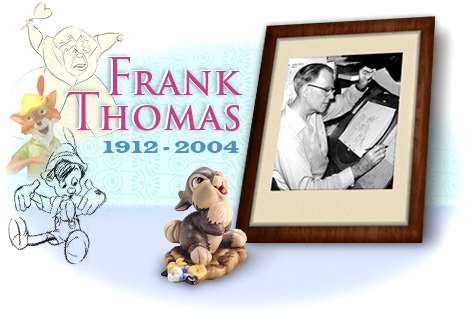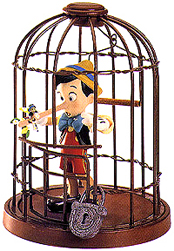Frank Thomas, one of the celebrated "Nine Old Men" of Disney animation whose work set the standards by which all character animation is judged, died quietly at his home in La Canada Flintridge on Wednesday, Sept. 9th, three days after his 92nd birthday. He had a long and distinguished career with Disney. He is credited with animating the Seven Dwarfs weeping at the heroine's bier in "Snow White and the Seven Dwarfs" (1937), Thumper and Bambi on the ice in "Bambi" (1942), Captain Hook dueling with Peter Pan in "Peter Pan" (1953) and Lady and Tramp falling in love over a plate of spaghetti and meatballs in "Lady and the Tramp" (1955) and Mad Madam Mim in the "Sword in the Stone" (1963). Animation historian John Canemaker said Wednesday that Thomas would "go down as one of the greatest animators of all time." Born in Santa Monica on Sept. 5. 1912, Thomas studied art at Stanford, where he met Ollie Johnston, who would become another of the Nine Old Men. The group got its name from Walt Disney as a play on the term President Franklin D. Roosevelt used to describe the Supreme Court. At the time, the veteran group of animators had barely reached middle age. Thomas and Johnston became lifelong friends and shared numerous professional assignments. Johnston, who at 91 is the only remaining one of the group, was not available for comment. In 1931, Frank met Ollie Johnston at Stanford University where they were both enrolled in the Art Department. However they discovered that they were more interested in gags and screwy routines for school shows than they were for painting and design classes. It was the beginning of a long friendship as they gained attention to their monthly cartoons in Stanford's humor magazine and developed a new perspective on college life. After college they came south to attend Chouinard's Art Institute where they studied with famed illustrator Pruett Carter. Suddenly drawing and design became very important. Carter's chief interest in his magazine work was in making the figures look like they were thinking and getting involved in the situations, and showing how they felt about their predicaments. This was a new philosophy for Frank and Ollie and one that stimulated the desires they had in their own drawings. It was still in their minds in 1934 when Carter stopped teaching and the two young students went to the Disney Studio seeking employment. Ollie had considered going into magazine illustration, but once he saw the acting possibilities in the animation, he was hooked. This was just what he had always wanted. Fortunately it was what Walt wanted too. This began a spectacular 43-year career at The Walt Disney Studio as top animators, directors and story men. Frank and Ollie gave the illusion of life to some of the most endearing animated characters to ever appear on the screen. Their humor, sensitivity, and acting abilities proved to have universal and lasting appeal and their skills at communicating these qualities in their drawings earned them places as two of Walt Disney's "Nine Old Men." Thomas did his first animation for the short "Mickey's Elephant" in 1936, but later remarked with customary humor that his first successful animation was in another Mickey Mouse short, "The Brave Little Tailor," two years later. Although he did noteworthy animation in various shorts, Thomas is primarily known for his work on the Disney features, beginning with his animation of the Seven Dwarfs in "Snow White." He shared the animation of the title characters in "Pinocchio" (1940) and "Bambi" (1942) with Johnston and Milt Kahl, another of the Nine Old Men. Thomas was responsible for some of the high points in both films: Pinocchio singing "I've Got No Strings" and Bambi wobbling his way across the ice with Thumper. Thomas was a member of "El Groupo," the cadre of artists who accompanied Walt Disney to South America in 1941 to gather material for the films that would become "Saludos Amigos" (1942) and "The Three Caballeros" (1944). But in 1942, Thomas joined the 18th Air Force Base Unit, also known as the First Motion Picture Unit, and spent most of the war making military training films. In 1946, he returned to Disney, where he helped to create such memorable characters as the wicked stepmother in "Cinderella" (1950), the Queen of Hearts in "Alice in Wonderland" (1951), Captain Hook in "Peter Pan," the title characters in "Lady and the Tramp" and the Three Good Fairies in "Sleeping Beauty" (1959). His later work included Pongo and Perdita in "101 Dalmatians" (1961), Baloo, Mowgli and Kaa in "The Jungle Book" (1967), King John and Sir Hiss in "Robin Hood" (1973), and Bernard and Bianca in "The Rescuers" (1977). Thomas handled some of the most emotionally complex scenes in the Disney features. When Grumpy, the self-styled "woman hater" among the dwarfs, buried his face in his hands at Snow White's bier, audiences wept, perhaps for the first time, at the pain of an animated character. Every parent could recognize Baloo's awkward body language as he tried to explain why Mowgli couldn't remain in the jungle. Thomas also conveyed Pinocchio's wonder when the audience cheered his clumsy song and dance. "I was looking for anything that showed he was only born last night," Thomas recalled in a 1998 interview. "He had no experience to draw on, so he had to be very wide-eyed and innocent looking." "To me, Frank's characters always had the most believable feeling of life on the screen -- to the point where it became hard to imagine someone actually creating them from drawings," said Disney animator Andreas Deja, whose work includes Lilo in "Lilo and Stitch." "When you look at Frank's work, you see characters who appear to be alive, which is the ultimate goal for any animator." Brad Bird, one of the new generation of artists that Thomas helped train, paid homage to Thomas and Johnston by including caricatures of them -- for which they supplied their own voices -- in Warner Bros.' "The Iron Giant" (1999) and the upcoming "The Incredibles" from Pixar. "The sheer [vastness] of his contribution to the art form is staggering," Bird said after hearing of Thomas' death. "He was among the last of his rare breed, and in terms of great animation, the bar remains where the Nine Old Men set it." During his last years at the studio, Thomas also helped train Glen Keane, John Pomeroy, Ron Clements and others who went on to animate the Disney hits of the 1990s.
Frank Thomas is a native Californian (born in Santa Monica). During World War II he was head of an Air Force Animation Unit, and from 1946 to 1966, in his spare time, was the piano player for the famous Dixieland Jazz group, The Firehouse Five plus Two with Ward Kimball, another of the Nine Old Men, formed with other Disney artists in 1948. The decades of work and friendship Thomas and Johnston shared were the subject of the 1995 documentary "Frank and Ollie," produced by Thomas' son and daughter-in-law, Theodore Thomas and Kuniko Okubo. In addition to awards from numerous animation festivals and organizations, they were honored by the Academy of the Motion Picture Arts and Sciences in 2003 when "Frank and Ollie: Drawn Together" was the subject of the annual Marc Davis Lecture on Animation. Frank Thomas and Ollie Johnston have co-authored four books about Disney animation and art. Disney Animation: Illusion of Life (1981) is considered a textbook of the art of Disney animation. Too Funny for Words (1987) covers the art of the physical gag in animation. Walt Disney's Bambi: The Story and the Film (1990) is a record of the making of the classic feature, and The Disney Villain (1994) is the decisive study of animated menace. Besides his son Theodore, Thomas is survived by his wife of 58 years, Jeanette; sons Doug and Gregg; daughter Ann Ayers; and three grandchildren. A memorial is being planned. The family suggests that donations in Thomas' name be made to the character animation program at CalArts, 24700 McBean Parkway, Valencia, CA 91355. |
|||||||||||||||||



